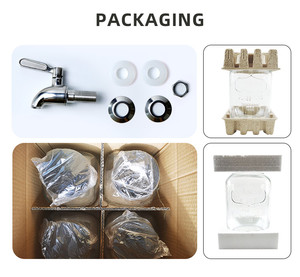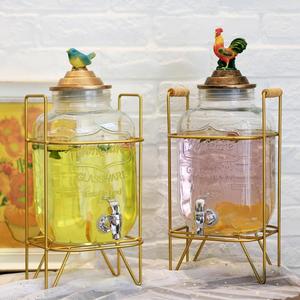(2863 products available)




















































































































































































































5 liter jars are large containers that come in different materials. They are designed for storage and packaging. These jars are commonly used in homes, businesses, and industries. Below are some of the types of 5-liter jars based on the materials used in making them.
Glass 5 Liter Jar
Glass jars are made from heavy, durable glass. They are transparent and odorless. Glass 5-liter jars are versatile. They can be used to store liquids such as juices and oil. They can also be used to store solid food items such as snacks. They are easy to clean and do not affect the taste of the stored products.
Plastic 5 Liter Jar
Plastic jars are made from high-density polyethylene (HDPE) plastic. They are lightweight and shatterproof. These jars are easy to carry and less likely to break compared to glass jars. They are commonly used for packaging cleaning agents and other non-food items.
Metal 5 Liter Jar
Metal jars are made from aluminum or stainless steel. They are durable and resistant to corrosion. These jars are often used for storing products that require protection from light and air. For instance, they can be used to store medicines.
Ceramic 5 Liter Jar
Ceramic jars are made from clay and other natural materials. They are heavy and durable. These jars are usually used for decorative purposes. They can be used to store food items like candies and biscuits.
Bamboo 5 Liter Jar
Bamboo jars are eco-friendly and biodegradable. They are made from natural bamboo material. These jars are lightweight and have a unique, rustic appearance. They are commonly used for packaging organic products.
Wide Mouth Jars:
Design for easy filling and cleaning. Opening bigger than the body. Suitable for storing thick products like honey or molasses.
Narrow Mouth Jars:
Opening smaller than the body. More challenging to fill and clean. Better for storing liquids that need pouring.
Shape and Structure:
Different shapes to choose from. Straight sides make stacking easy. Curved sides add style. Some have shoulders to help with handling. Ensure sturdiness to prevent breakage.
Design Elements:
Clear glass or plastic to see contents. Tinted glass protects from UV light. Decorative designs for branding or aesthetics. Labels can be applied or embossed.
Neck and Finish:
Neck size affects closure types. Standard neck for screw tops. Wide neck for easy filling. Special finishes for airtight seals.
Materials:
Glass jars are strong and recyclable but breakable. Plastic jars are lightweight and durable, but usually, they are not recyclable. BPA-free plastic is safe for food and drinks. Composite material jars combine strengths of both material types.
Closure Options:
Various closure options available to maintain product safety and freshness. Screw-on lids have ridges for a secure twist-on seal. Pop-up caps allow easy opening and resealing. Cork stoppers give a natural look and seal. Airtight seals keep products fresh; choose closures that match the jar neck size.
Compatibility with Dispensing:
Some jars come with pump tops for easy dispensing of lotions or creams. Flip-top lids combine convenience and quick access for products like vitamins. Jar with sprayers allows even misting for cleaners and air fresheners. Bulk jars enable easy filling from larger containers for commercial use.
Sustainability Aspects:
Glass jars can be reused and recycled, supporting eco-friendliness. Plastic jars may come in recyclable materials to reduce waste. Manufacturers are using biodegradable materials for the sustainable future. Businesses should check the sustainability features of jars to meet eco-friendly goals.
5-liter jars are useful in industrial and commercial applications. They store and supply large amounts of liquid products. Some common usage scenarios are:
Food and Beverage Industry:
5-liter jars are ideal for packaging sauces, dressings, and marinades. Manufacturers pour these flavorful condiments into jars. Restaurants and catering services use them to store and serve such items. They also package and supply fruit juices and non-carbonated drinks.
Retail and Wholesale:
Retailers use 5-liter jars to sell bulk products. Items such as cleaning agents, personal care products, and oils go into the jars. The clear glass or plastic allows customers to see the product. It increases trust and confidence. The jars are also suitable for storing and distributing spices and seasonings.
Pharmaceutical and Healthcare Products:
Pharmaceutical companies use 5-liter jars to package liquid medicines. Herbal remedies and large-volume health supplements also go into the jars. The tight sealing ensures that the products stay fresh and effective. It also reduces the risk of contamination.
Industrial and Lubricants:
Manufacturers of lubricants and industrial fluids use 5-liter jars for packaging. The jars are suitable for hydraulic fluids, lubricating oils, and cleaning solvents. The sturdy design can withstand the weight of dense fluids.
Laboratory and Research Facilities:
In laboratories, researchers use 5-liter jars to store chemicals, reagents, and solutions. The wide opening allows for easy pouring and handling. It is also suitable for storing large-volume samples.
Gardening and Horticulture:
5-liter jars store fertilizers and pesticides. They keep the chemicals safe until the gardener is ready to use them. Some creative individuals also turn jars into self-watering planters.
Arts and Crafts:
5-liter jars give crafters a media to work with. They can use them to create unique and functional art pieces. Projects include customized storage solutions and decorative light fixtures.
Purpose and Usage:
Clearly define what the jar will be used for. Consider what products will be stored inside the jar. Will it be food items, chemicals, or office supplies? If storing food, ensure the jar is FDA-approved for food contact. If storing non-food items, consider the material and closure type.
Material:
Glass Jars: Glass jars are recyclable and provide an upscale look. However, they are heavier and more fragile, increasing the risk of breakage.
Plastic Jars: Plastic 5-liter jars are lightweight and durable. They can withstand drops and are more cost-effective. However, plastic can scratch and may not be suitable for high-heat or chemical environments.
Shape and Design:
Consider the storage space and how the jars will be organized. Some shapes stack better, while others are easier to access. Ensure the jar design complements the brand image if used for marketing.
Neck and Opening Size:
The opening should be large enough for easy access to the contents. If transferring items in and out frequently, consider a wider neck opening.
Closure Type:
Choose closures that provide the appropriate seal for the stored items. Screw-on lids are great for a tight seal, while snap-on lids provide easy access. Pumps and dispensers minimize mess for liquids and powders.
Regulatory Compliance:
Ensure the jars meet local and national regulations for product packaging. Food-grade compliance is crucial for jars storing consumables.
Cost and Budget:
Determine the total cost considering the purchase price and any additional expenses, such as shipping and customization. Choose the best quality within budget.
Customization Options:
If branding is essential, explore customization options like labels and jar designs. Custom labels can help identify products and promote the brand to customers.
Supplier Reputation:
Choose a reputable supplier with positive reviews. Ask for samples before making a bulk purchase to ensure the jars meet quality standards.
Q1. What is a 5-liter jar used for?
A1. 5-liter jars are suitable for storing large quantities of goods.
Q2. What are the advantages of using 5-liter jars?
A2. The advantages of 5-liter jars include cost-effectiveness, durability, and easy-to-read markings.
Q3. Can 5-liter jars be reused?
A3. Yes, 5-liter jars can be reused for various purposes.
Q4. How should 5-liter jars be stored?
A4. 5-liter jars should be stored in a cool, dry place away from direct sunlight.
Q5. Do 5-liter jars come with different types of closures?
A5. 5-liter jars are available with various closures, including screw caps, corks, and snap-on lids.